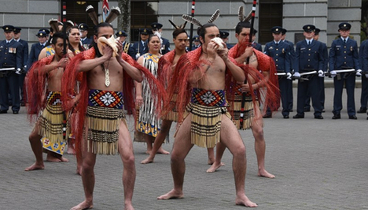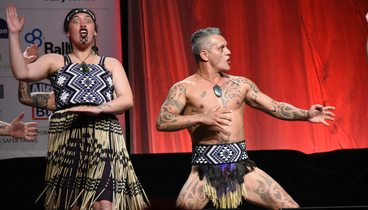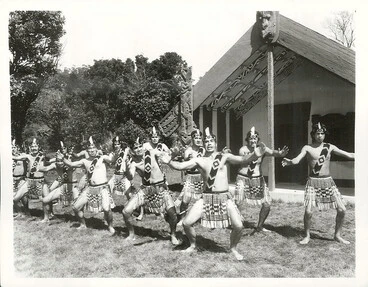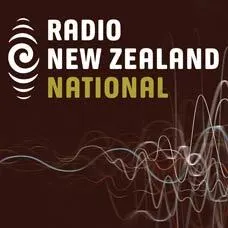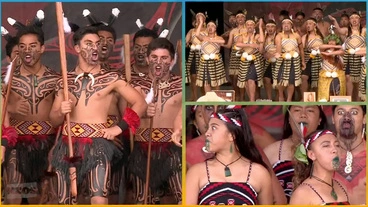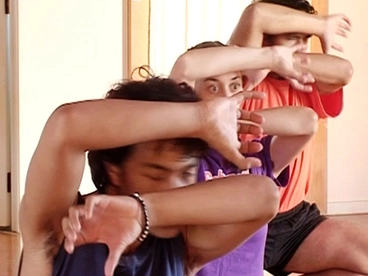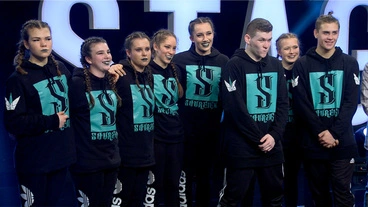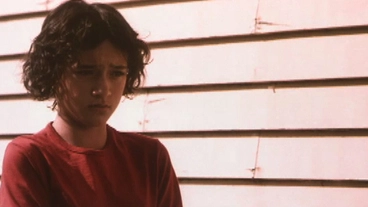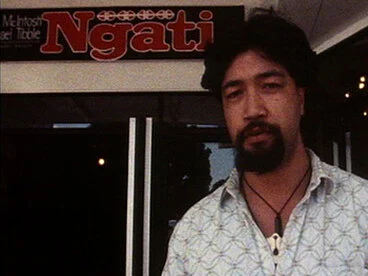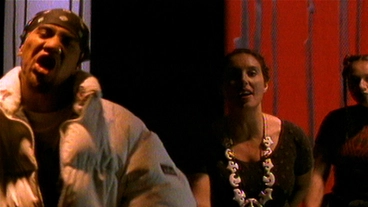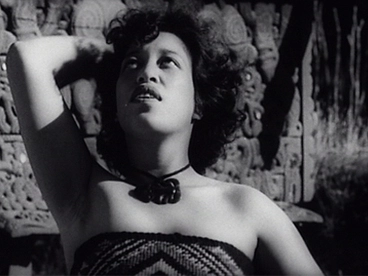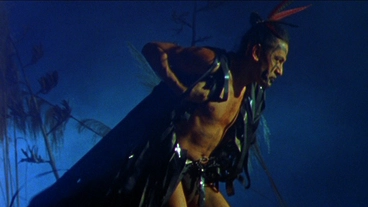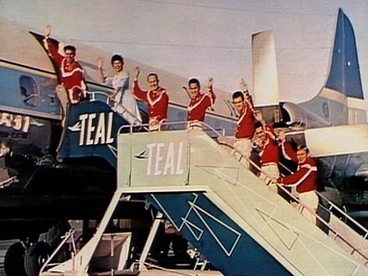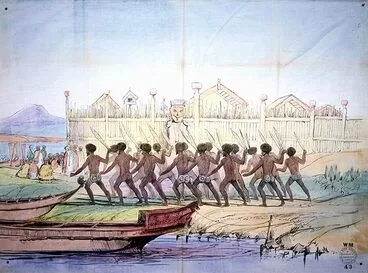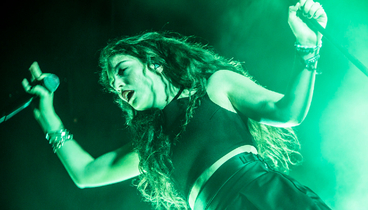Māori Music and Performance
A DigitalNZ Story by National Library of New Zealand Topics
Explore the Māori culture, history and uses of taonga puoro along with waiata, famous singers (traditional and contemporary), music awards, styles and contribution of Māori to theatre, film, dance and the unique performances that are waiata ā ringa and kapa haka. SCIS no: 1921970
Maisey Rika
Manatū Taonga, the Ministry for Culture and Heritage
Ngā pūoro Māori (Māori music)
National Library of New Zealand
Kapa haka
National Library of New Zealand
Polynesian Festival Publicity Caption: First National Polynesian Festival Competitions Rotorua 1972. Waihirere team from Gisborne
Archives New Zealand Te Rua Mahara o te Kāwanatanga
Māori music record
A suggestion to record the Rotorua Māori Choir was made to Columbia Gramophone Company in 1929. This led to a contract being signed by three choir members – Geoffrey Rogers, Tame Petane, and Rotohiko Haupapa. The Rotorua Māori Choir was accompanied by Ana Hato and Deane Waretini. They were recorded at the Tūnohopu meeting house at Ohinemutu in Rotorua. The control room was set up on the porch and the recording room had shawls and carpets hung from the rafters to soften the echo. The recording sessions were long taking months to complete. The songs comprised folk songs, love songs, farewell songs, welcome songs, as well as two English hymns in te reo, ‘Au e Iho,’ and ‘Karaunatia.’
Alexander Turnbull Library
Kapa Haka group, Glendale School, Wainuiomata - Photograph taken by Ross Giblin
Alexander Turnbull Library
Maori music awards celebrate Maori music, artists
Radio New Zealand
Origins of contemporary waiata
Manatū Taonga, the Ministry for Culture and Heritage
Te Matatini Festival
Services to Schools
Māori musical concepts
Manatū Taonga, the Ministry for Culture and Heritage
Māori composers – ngā kaitito waiata
Manatū Taonga, the Ministry for Culture and Heritage
Making Music - Mika
NZ On Screen
The Stage - Haka Fusion - First Episode
NZ On Screen
Powhiri 101
Radio New Zealand
Whale Rider
NZ On Screen
Koha - Nga Pikitia Māori
NZ On Screen
First decades of Māori radio
Manatū Taonga, the Ministry for Culture and Heritage
Have we been singing 'Tutira Mai Nga Iwi' wrong?
Radio New Zealand
Māori theatre – te whare tapere hōu
Manatū Taonga, the Ministry for Culture and Heritage
Treaty
NZ On Screen
New Zealand Mirror No. 14
NZ On Screen
Ahi Ataahua
NZ On Screen
Alien Weaponry rediscover te reo
Radio New Zealand
Upper Hutt Posse: 'E tu'
Manatū Taonga, the Ministry for Culture and Heritage
Upper Hutt Posse - Photograph taken by John Nicholson
Alexander Turnbull Library
Common Unity: Marley’s Aotearoa legacy 40 years on
Radio New Zealand
The music of Māori chant
Services to Schools
Richard Nunns
Services to Schools
Types of haka
Services to Schools
Hei Waiata, Hei Whakakoakoa
Services to Schools
Māori Language Week performance
Services to Schools
A wedding with a Māori twist
Services to Schools
Māori and Pacifica bands and musicians
Services to Schools
Māori artists
Services to Schools
Te Wiki o te reo Māori
Services to Schools
Māori musical instruments
Services to Schools
‘Now is the hour,’ NZ's first million-selling song?
Services to Schools
Rotorua Club
Services to Schools
Thriller Haka to Poi E From Taika Waititi's "Boy"
Services to Schools
Inia Te Wiata
Services to Schools
A Māori concert at Bulls
Services to Schools
Dame Kiri Te Kanawa
Services to Schools
Theme from Once were Warriors
Services to Schools
The Power of Music (Te Kaha o Te Waiata)
Services to Schools
Māori dance
Services to Schools
How to make a play piupiu
Services to Schools
Kete Aronui
Services to Schools
Playing the rōria
Services to Schools
Corporal Anaia Amohau
This is Corporal Anaia Amohau conducting the Māori choir singing ‘Māori Battalion’ at Helwan camp in Egypt during World War Two. Amohau started writing the words while he was in Rotorua in 1939. The song which is sung to the tune of ‘The Washington & Lee Swing’ is about the honour, bravery and courage of the 28th Māori Battalion. It soon became the marching song of Te Arawa. The song became so popular, it was sung in bars, music halls and wherever Māori soldiers gathered. ‘AU-E! ake kia kaha e!’ is a famous line from the song that spurred the Māori Battalion on to fight for God, for King and for Country.
Alexander Turnbull Library
Māori opera ‘Tapu’
The opera Tapu (meaning sacred in Māori) was composed by Alfred Hill in 1902 and performed by the Pollard Opera Company first in Wellington then Sydney in 1904. The theme was based on the power of the Māori tohunga (priest) and the plot was structured around an Australian politician George Wright who visited New Zealand, with the intention to unify the two countries. Eventually, the politician had to be rescued from a cooking pot. Most reviews stated that the opera was well received with much appreciation for the setting, music and dances, except for one review who felt that the dialogue was weak. However, Mr Hill was called upon to make several curtain calls.
National Library of New Zealand
Powhiri for Vietnam veterans
This photo was taken at the powhiri for Vietnam war veterans on Wellington’s Taranaki Street Wharf in 1998. Powhiri is a process where Tangata Whenua (hosts) welcome manuhiri (visitors) onto a marae. However there are other welcoming occasions, and places where powhiri are performed, as shown in this image. The powhiri is meant to initiate the beginning of a respectful relationship between two groups. One of the women has a taiaha, a well-known Māori weapon. These were usually made from wood or whalebone.
Alexander Turnbull Library
Scene from Once were warriors.
Alan Duff, the well-known New Zealand novelist published his book ‘Once Were Warriors’ in 1990. Auckland film company Communicado Features Limited bought the rights to the book and turned it into a feature film. The story is about a Māori family descended from warriors and their struggle to cope with domestic violence and the frustration of being social outcasts in their own land. This photo was taken at a rehearsal. It shows Rene Owen (Beth Heke) beside her daughter’s coffin.
Alexander Turnbull Library
Māori woman performing an action song
The facial expression (called pukana) of this Māori woman performing a waiata-ā-ringa – Māori action song is as important as the movement of her hand and body. A Māori action song is more than just entertainment. The lyrics of the song, facial expressions and the movement of the body, hands and legs convey deep feelings and ideas. This can only be achieved after practising the technique under experienced professionals. Waiata-ā-ringa can be fast, slow, serious or fun. Āpirana Ngata and Te Puea Hērangi are two famous composers of waiata-ā-ringa from the early 1900s.
Alexander Turnbull Library
Māori performers in a fix
Māori entertainment groups were popular in New Zealand and overseas tours also found appreciative audiences from the early 19th century. This article from 1919 is about a Māori troupe visiting America to perform. On reaching the port in San Francisco the group cheerfully walked down the gangplank in their native costumes made from feathers of the bird of paradise and other birds. Their costumes were immediately confiscated because the only way such feathers could enter America would be for an exhibition at a public museum. The group complained that they could not perform without their costumes. It was only special permission obtained from Washington that exempted them from this rule. The g
National Library of New Zealand
Māori women singing and using poi
Three Māori women pose singing for an unknown artist. Each has a poi which she flings over her left shoulder. Traditionally poi were soft balls made from raupo attached to a flax string. Dancers use a hitting or flowing technique with poi when performing. Here they stand close to each other, however realistically they would need to be at a distance from each other to allow free movement of the poi. Originally poi was used by warriors to improve the flexibility and skilfulness of their wrists. The women are dressed for the occasion with beautiful cloaks, each patterned differently with taniko designs. Taniko designs have special significance for whanau (family) or iwi (tribe).
Alexander Turnbull Library
He Ara Pūoro
Services to Schools
E Kō, E Kō - Morning Chorus
Services to Schools
Voices of Tāwhirimatea
Services to Schools
Hinewehi Mohi
Services to Schools
New Zealand Music
DigitalNZ
Māori Religious Movements
DigitalNZ

